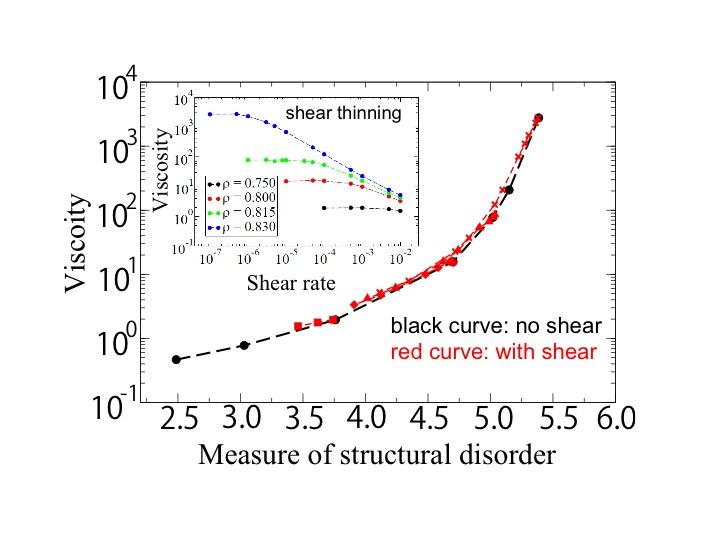Tokyo - Researchers at The University of Tokyo discover that the two-body structural entropy is the key quantity to understanding the dynamics of sheared supercooled liquids and also the mechanism behind the phenomenon "shear thinning".
Supercooled liquids
Despite their apparent familiarity, liquids are the least-understood state of matter. Being intermediate between gases and solids, their behavior is an unpredictable mixture of both. Particularly unusual are glass-forming liquids, which can be cooled below their freezing point without crystallizing. Such supercooled liquids become more and more gooey (or, viscous) with a decrease in temperature and eventually become glassy solids (glasses) below the glass transition temperature. We see this kind behavior in the glass blowing process to make a beautiful glassware.
Now, in a paper published in PNAS, two researchers at The University of Tokyo's Institute of Industrial Science (IIS) have revealed new insights into the behavior of supercooled liquids when they are made to flow by "pulling on them", also called "shearing".
Sheared supercooled liquids
Initially, as a supercooled liquid is made to flow by shearing ("pulling") its viscosity remains unchanged but as the liquid is made to flow faster and faster the viscosity surprisingly starts to decrease and it becomes more easy for the liquid to flow (i.e. it becomes less gooey). This phenomenon is called shear thinning and is an industrially very important process used, for instance, when two surfaces are to slide easily against each other by lubricants. Despite decades of research and great effort by many researchers the mechanism behind shear thinning remains unknown.
Exploiting the rise in computational power, the IIS researchers used graphics card (GPU) computer simulations to simulate several computer model supercooled liquids as they are made to flow by shear. The sheared supercooled liquid not only flows more easily, but also the arrangements of the molecules are changed with faster flow (also called the structure of the liquid). These facts make sheared supercooled liquids hard to describe using fundamental theories. The IIS researchers instead used a well-known concept in physics called the "entropy" to describe sheared supercooled liquid dynamics. Entropy is a measure for how ordered a system is; a crystal tends to be more ordered than a liquid and thus have lower entropy.
"By considering the arrangement of molecules under shear we could connect the behavior of supercooled liquids under shear to a fundamental concept in physics, namely the entropy; or more specifically, the two-body structural entropy." says co-author Trond S. Ingebrigtsen. "Furthermore, as the two-body entropy can be calculated easily in experiments our results can be verified not only by computer simulations. Previous attempts at using the two-body entropy ran into problems as the change in the arrangements of the molecules under shear, or structural anisotropy, was not taken into account."
As a liquid is made to flow faster and faster under shear the arrangement of the molecules must adjust to the new situation and induces what is called structural anisotropy in the liquid. This means that, for instance, the structure measured with respect to the flow direction will turn out to be different and influences the properties of the system as a whole.
"By modifying the two-body entropy to take into account these structural changes occurring under shear we were able to describe sheared dynamics using the behavior of the liquid without shear. We found that the two-body entropy calculated along the so-called extensional axis of the flow was the key quantity to describing sheared dynamics. The two-body entropy in the other directions could be safely ignored", Ingebrigtsen says. "Intuitively, the structure along the extensional direction is important as the shear flow in this direction opens up for more space and the molecules can more easily escape."
The computer simulations did not uncover the full mechanism behind shear thinning but discovering the correlation of sheared dynamics to the two-body structural entropy provided new insights into how to understand the structural changes relevant for understanding the phenomenon of shear thinning.
"We were very pleased that all our simulated model liquids gave such clear results, since they were chosen to cover a very wide-range of model liquids especially relevant for experiments," co-author Hajime Tanaka explains. "Now, the challenge is to understand in more detail the microscopic mechanism behind these observations to fully understand the mechanism behind shear thinning. We remain very positive in this respect."
The article, "Structural predictor for nonlinear sheared dynamics in simple glass-forming liquids," was published in PNAS at DOI:10.1073/pnas.1711655115.
Journal article
Trond S. Ingebrigtsen and Hajime Tanaka, "Structural predictor for nonlinear sheared dynamics in simple glass-forming liquids", Proceedings of the National Academy of Sciences of the United States of America (PNAS)
Research Contact
Hajime Tanaka, Professor
Tel: +81 3 5452-6125
Fax: +81 3 5452-6126
URL: http://tanakalab.iis.u-tokyo.ac.jp/Top_E.html
Material
Relationship between structural measure and viscosity Relationship between a measure of structural disorder and viscosity for a polydisperse hard-sphere-like system. The relationship between the structural measure and the viscosity can be collapsed on their relation in a quiescent state. The inset shows the shear-rate dependence of the viscosity for various densities ρ. Shear thinning takes place for a lower shear rate for a liquid with higher density.

